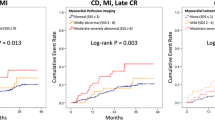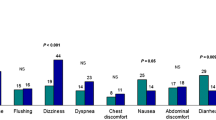Abstract
Background
Thallium-201 washout rate of stress myocardial perfusion imaging (MPI) has been reported to correlate with coronary flow reserve which is a parameter of myocardial microcirculation. However, the evidence for its use in diabetic kidney disease (DKD) has been lacking, and the association between thallium-201 washout rate and adverse outcomes including death is unknown. Therefore, the present study was conducted to evaluate the predictive ability of thallium-201 washout rate for mortality in DKD patients initiating hemodialysis.
Methods
A total of 96 patients with type 2 diabetes who had been started on maintenance hemodialysis undergoing stress MPI with thallium-201 within 1 year, 72 men and 24 women, with a median age of 67 years, were studied. The endpoint was defined as all-cause death. The Cox proportional hazards model was used to calculate hazard ratios (HR) and 95% confidence intervals (CI).
Results
During the mean follow-up period of 3.4 ± 2.1 years, 18 (18.8%) deaths occurred. Cumulative survival rates during the follow-up period, with thallium-201 washout rate levels in the lowest tertile (3.1–36.2%), the middle tertile (36.5–46.3%), and the highest tertile (46.4–66.2%), were 51.0, 86.5, and 85.3%, respectively. Overall, the multivariate Cox regression analysis revealed that thallium-201 washout rate remained an independent predictor of death after adjusting by confounding variables (HR 0.91, 95% CI 0.85–0.97).
Conclusions
Among DKD patients initiating hemodialysis, thallium-201 washout rate seems to be useful for predicting death.



Similar content being viewed by others
References
de Boer IH, Rue TC, Hall YN, Heagerty PJ, Weiss NS, Himmelfarb J. Temporal trends in the prevalence of diabetic kidney disease in the United States. JAMA. 2011;305(24):2532–9.
Ronco C, McCullough P, Anker SD, Anand I, Aspromonte N, Bagshaw SM, Bellomo R, Berl T, Bobek I, Cruz DN, Daliento L, Davenport A, Haapio M, Hillege H, House AA, Katz N, Maisel A, Mankad S, Zanco P, Mebazaa A, Palazzuoli A, Ronco F, Shaw A, Sheinfeld G, Soni S, Vescovo G, Zamperetti N, Ponikowski P. Acute dialysis quality initiative (ADQI) consensus group: cardio-renal syndromes: report from the consensus conference of the acute dialysis quality initiative. Eur Heart J. 2010;31:703–11.
Fox CS, Matsushita K, Woodward M, Bilo HJ, Chalmers J, Heerspink HJ, Lee BJ, Perkins RM, Rossing P, Sairenchi T, Tonelli M, Vassalotti JA, Yamagishi K, Coresh J, de Jong PE, Wen CP, Nelson RG. Chronic kidney disease prognosis consortium: associations of kidney disease measures with mortality and end-stage renal disease in individuals with and without diabetes: a meta-analysis. Lancet. 2012;380(9854):1662–73.
Moroi M, Tamaki N, Nishimura M, Haze K, Nishimura T, Kusano E, Akiba T, Sugimoto T, Hase H, Hara K, Nakata T, Kumita S, Nagai Y, Hashimoto A, Momose M, Miyakoda K, Hasebe N, Kikuchi K. Association between abnormal myocardial fatty acid metabolism and cardiac-derived death among patients undergoing hemodialysis: results from a cohort study in Japan. Am J Kidney Dis. 2013;61:466–75.
Foley RN, Parfrey PS, Sarnak MJ. Epidemiology of cardiovascular disease in chronic renal disease. J Am Soc Nephrol. 1998;9(12 Suppl):S16–23.
K/DOQI Workgroup. K/DOQI clinical practice guidelines for cardiovascular disease in dialysis patients. Am J Kidney Dis. 2005;45(4 Suppl 3):S1–153.
Hamby RI, Zoneraich S, Sherman L. Diabetic cardiomyopathy. JAMA. 1974;229(13):1749–54.
McDonagh PF, Hokama JY. Microvascular perfusion and transport in the diabetic heart. Microcirculation. 2000;7(3):163–81.
Mohandas R, Segal MS, Huo T, Handberg EM, Petersen JW, Johnson BD, Sopko G, Bairey Merz CN, Pepine CJ. Renal function and coronary microvascular dysfunction in women with symptoms/signs of ischemia. PLoS One. 2015;10(5):e0125374.
Chade AR, Brosh D, Higano ST, Lennon RJ, Lerman LO, Lerman A. Mild renal insufficiency is associated with reduced coronary flow in patients with non-obstructive coronary artery disease. Kidney Int. 2006;69(2):266–71.
Ragosta M, Samady H, Isaacs RB, Gimple LW, Sarembock IJ, Powers ER. Coronary flow reserve abnormalities in patients with diabetes mellitus who have end-stage renal disease and normal epicardial coronary arteries. Am Heart J. 1004;147(6):1017–23.
Amann K, Breitbach M, Ritz E, Mall G. Myocyte/capillary mismatch in the heart of uremic patients. J Am Soc Nephrol. 1998;9(6):1018–22.
Amann K, Neusüss R, Ritz E, Irzyniec T, Wiest G, Mall G. Changes of vascular architecture independent of blood pressure in experimental uremia. Am J Hypertens. 1995;8(4 Pt 1):409–17.
Barenbrock M, Spieker C, Laske V, Heidenreich S, Hohage H, Bachmann J, Hoeks AP, Rahn KH. Studies of the vessel wall properties in hemodialysis patients. Kidney Int. 1994;45(5):1397–400.
Rostand SG, Kirk KA, Rutsky EA. Dialysis-associated ischemic heart disease: insights from coronary angiography. Kidney Int. 1984;25(4):653–9.
Miyagawa M, Kumano S, Sekiya M, Watanabe K, Akutzu H, Imachi T, Tanada S, Hamamoto K. Thallium-201 myocardial tomography with intravenous infusion of adenosine triphosphate in diagnosis of coronary artery disease. J Am Coll Cardiol. 1995;26(5):1196–201.
Watanabe K, Sekiya M, Ikeda S, Miyagawa M, Kinoshita M, Kumano S. Comparison of adenosine triphosphate and dipyridamole in diagnosis by thallium-201 myocardial scintigraphy. J Nucl Med. 1997;4:577–81.
Beller GA, Holzgrefe HH, Watson DD. Intrinsic washout rates of thallium-201 in normal and ischemic myocardium after dipyridamole-induced vasodilation. Circulation. 1985;71(2):378–86.
Abdulla A, Maddahi J, Garcia E, Rozanski A, Swan HJ, Berman DS. Slow regional clearance of myocardial thallium-201 in the absence of perfusion defect: contribution to detection of individual coronary artery stenoses and mechanism for occurrence. Circulation. 1985;71(1):72–9.
Teragawa H, Yamagata T, Kato M, Hiraga M, Matsuura H, Kajiyama G. Assessment of the severity of coronary artery stenosis by the ratio of the regional washout rate determined by adenosine triphosphate stress Tl-201 SPECT. J Nucl Cardiol. 1999;6(3):324–31.
Hayashi M, Kambara H, Nohara R, Fudo T, Hashimoto T, Kawai C, Tamaki N, Yonekura Y, Konishi J. Evaluation and clinical use of early washout ratio of thallium-201 in normal and ischemic myocardium after dipyridamole-induced vasodilation using ring-type emission computed tomography. Jpn Circ J. 1991;55(3):194–203.
Tamoto S, Ishihara T, Kojima S, Hosokawa H, Ohkubo T, Ohtuji S, Fukai M, Takada K, Seki I, Ohsawa N, Adachi I, Narabayashi I. Assessment of the severity of coronary artery disease by thallium-201 washout rate after dipyridamole infusion-a coronary hemodynamic and metabolic study. Jpn Circ J. 1995;59(1):11–22.
Kashiwagi A, Kasuga M, Araki E, Oka Y, Hanafusa T, Ito H, Tominaga M, Oikawa S, Noda M, Kawamura T, Sanke T, Namba M, Hashiramoto M, Sasahara T, Nishio Y, Kuwa K, Ueki K, Takei I, Umemoto M, Murakami M, Yamakado M, Yatomi Y, Ohashi H. Committee on the standardization of diabetes mellitus-related laboratory testing of Japan diabetes society (JDS): International clinical harmonization of glycated hemoglobin in Japan: From Japan diabetes society to national glycohemoglobin standardization program values. J Diabetes Invest. 2012;3:39–40.
Matsuo S, Imai E, Horio M, Yasuda Y, Tomita K, Nitta K, Yamagata K, Tomino Y, Yokoyama H, Hishida A. Collaborators developing the Japanese equation for estimated GFR: revised equations for estimated GFR from serum creatinine in Japan. Am J Kidney Dis. 2009;53:982–92.
Fukagawa M, Yokoyama K, Koiwa F, Taniguchi M, Shoji T, Kazama JJ, Komaba H, Ando R, Kakuta T, Fujii H, Nakayama M, Shibagaki Y, Fukumoto S, Fujii N, Hattori M, Ashida A, Iseki K, Shigematsu T, Tsukamoto Y, Tsubakihara Y, Tomo T, Hirakata H, Akizawa T. CKD-MBD Guideline Working Group; Japanese Society for Dialysis Therapy: clinical practice guideline for the management of chronic kidney disease-mineral and bone disorder. Ther Apher Dial. 2013;17(3):247–88.
Yokoyama I, Momomura S, Ohtake T, Yonekura K, Nishikawa J, Sasaki Y, Omata M. Reduced myocardial flow reserve in non-insulin-dependent diabetes mellitus. J Am Coll Cardiol. 1997;30(6):1472–7.
Niizuma S, Takiuchi S, Okada S, Horio T, Kamide K, Nakata H, Yoshihara F, Nakamura S, Kawano Y, Nakahama H, Iwanaga Y, Nakatani S. Decreased coronary flow reserve in haemodialysis patients. Nephrol Dial Transplant. 2008;23(7):2324–8.
Tok D, Gullu H, Erdogan D, Topcu S, Ciftci O, Yildirim I, Muderrisoglu H. Impaired coronary flow reserve in hemodialysis patients: a transthoracic Doppler echocardiographic study. Nephron Clin Pract. 2005;101(4):c200–6.
Nakanishi K, Fukuda S, Shimada K, Miyazaki C, Otsuka K, Kawarabayashi T, Watanabe H, Yoshikawa J, Yoshiyama M. Prognostic value of coronary flow reserve on long-term cardiovascular outcomes in patients with chronic kidney disease. Am J Cardiol. 2013;112(7):928–32.
Murthy VL, Naya M, Foster CR, Hainer J, Gaber M, Dorbala S, Charytan DM, Blankstein R, Di Carli MF. Coronary vascular dysfunction and prognosis in patients with chronic kidney disease. JACC Cardiovasc Imaging. 2012;5(10):1025–34.
Shah NR, Charytan DM, Murthy VL, Skali Lami H, Veeranna V, Cheezum MK, Taqueti VR, Kato T, Foster CR, Hainer J, Gaber M, Klein J, Dorbala S, Blankstein R, Di Carli MF. Prognostic value of coronary flow reserve in patients with dialysis-dependent ESRD. J Am Soc Nephrol. 2016;27(6):1823–9.
Fukuda H, Moroi M. Prediction of cardiac events in patients with transient left ventricle dilation on stress myocardial perfusion SPECT images. Circ J. 2005;69(10):1223–9.
Goto T, Ohte N, Miyabe H, Mukai S, Sakata S, Hayano J, Kimura G. Tl-201 washout rate in remote normal regions in patients with prior myocardial infarction and left ventricular remodeling. J Nucl Cardiol. 2005;12(2):179–85.
Strauer BE, Motz W, Vogt M, Schwartzkopff B. Impaired coronary flow reserve in NIDDM: a possible role for diabetic cardiopathy in humans. Diabetes. 1997;46(Suppl 2):S119–24.
Ledet T. Diabetic cardiopathy. Quantitative histological studies of the heart from young juvenile diabetics. Acta Pathol Microbiol Scand A. 1976;84(5):421–8.
Fein FS, Sonnenblick EH. Diabetic cardiomyopathy. Cardiovasc Drugs Ther. 1994;8(1):65–73.
Nitenberg A, Paycha F, Ledoux S, Sachs R, Attali JR, Valensi P. Coronary artery responses to physiological stimuli are improved by deferoxamine but not by l-arginine in non-insulin-dependent diabetic patients with angiographically normal coronary arteries and no other risk factors. Circulation. 1998;97(8):736–43.
Miura H, Wachtel RE, Loberiza FR Jr, Saito T, Miura M, Nicolosi AC, Gutterman DD. Diabetes mellitus impairs vasodilation to hypoxia in human coronary arterioles: reduced activity of ATP-sensitive potassium channels. Circ Res. 2003;92(2):151–8.
Shivu GN, Phan TT, Abozguia K, Ahmed I, Wagenmakers A, Henning A, Narendran P, Stevens M. Frenneaux: relationship between coronary microvascular dysfunction and cardiac energetics impairment in type 1 diabetes mellitus. Circulation. 2010;121(10):1209–15.
Wong TY, Klein R, Sharrett AR, Duncan BB, Couper DJ, Tielsch JM, Klein BE, Hubbard LD. Retinal arteriolar narrowing and risk of coronary heart disease in men and women. The Atherosclerosis Risk in Communities Study. JAMA. 2002;287(9):1153–9.
Chen HC, Chou CY, Hsiao YT, Liang CC, Kuo HL, Chang CT, Liu JH, Wang IK, Huang CC. Patients with diabetes as the primary kidney disease have a worse survival than patients with comorbid diabetes in chronic haemodialysis patients. Nephrology (Carlton). 2015;20(3):155–60.
Author information
Authors and Affiliations
Corresponding author
Ethics declarations
Conflict of interest
All authors have no conflicts of interest to declare in connection with this paper.
Ethical statement
This study adhered to the Declaration of Helsinki. The Ethics Committee for Clinical Research at Toho University Ohashi Medical Center approved the study protocol [Permission no. 13-52 and 13-61].
Informed consent
All patients provided informed consent to participate in the study.
About this article
Cite this article
Hayashi, T., Joki, N., Tanaka, Y. et al. Thallium-201 washout rate of stress myocardial perfusion imaging as a predictor of mortality in diabetic kidney disease patients initiating hemodialysis: an observational, follow-up study. Clin Exp Nephrol 22, 142–150 (2018). https://doi.org/10.1007/s10157-017-1414-9
Received:
Accepted:
Published:
Issue Date:
DOI: https://doi.org/10.1007/s10157-017-1414-9




